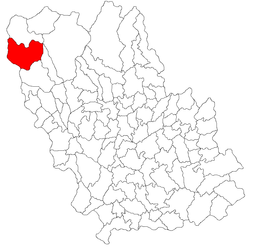This article includes a list of general references, but it lacks sufficient corresponding inline citations. (June 2011) |
Sinaia | |
|---|---|
| |
 Location in Prahova County | |
| Coordinates: 45°21′0″N 25°33′5″E / 45.35000°N 25.55139°E | |
| Country | Romania |
| County | Prahova |
| Government | |
| • Mayor (2020–2024) | Vlad Gheorghe Oprea[1] (PNL) |
| Area | 89.27 km2 (34.47 sq mi) |
| Population (2021-12-01)[2] | 9,071 |
| • Density | 100/km2 (260/sq mi) |
| Time zone | EET/EEST (UTC+2/+3) |
| Vehicle reg. | PH |
| Website | www |
Sinaia (Romanian pronunciation: [siˈnaja]) is a town and a mountain resort in Prahova County, Romania. It is situated in the historical region of Muntenia. The town was named after the Sinaia Monastery of 1695, around which it was built. The monastery, in turn, is named after the Biblical Mount Sinai. King Carol I of Romania also built his summer residence, Peleș Castle, in Sinaia in the late nineteenth century.
Sinaia is about 65 kilometres (40 miles) northwest of Ploiești and 48 kilometres (30 miles) south of Brașov, in a mountainous area on the Prahova River valley, just east of the Bucegi Mountains. The town's altitude varies between 767 to 860 metres (2,516 to 2,822 feet) above sea level.
The city is a popular destination for hiking and winter sports, especially downhill skiing. Among the tourist landmarks, the most important are Peleș Castle, Pelișor Castle, Sinaia Monastery, Sinaia Casino, Sinaia train station, and the Franz Joseph and Saint Anne Cliffs. Sinaia was also the summer residence of the Romanian composer George Enescu, who stayed at the Luminiș villa.
| Year | Pop. | ±% |
|---|---|---|
| 1912 | 3,919 | — |
| 1930 | 4,072 | +3.9% |
| 1948 | 6,537 | +60.5% |
| 1956 | 9,006 | +37.8% |
| 1966 | 11,976 | +33.0% |
| 1977 | 13,822 | +15.4% |
| 1992 | 15,465 | +11.9% |
| 2002 | 14,636 | −5.4% |
| 2011 | 10,410 | −28.9% |
| 2021 | 9,071 | −12.9% |
| Source: Census data | ||
- ^ "Results of the 2020 local elections". Central Electoral Bureau. Retrieved 9 June 2021.
- ^ "Populaţia rezidentă după grupa de vârstă, pe județe și municipii, orașe, comune, la 1 decembrie 2021" (XLS). National Institute of Statistics.






